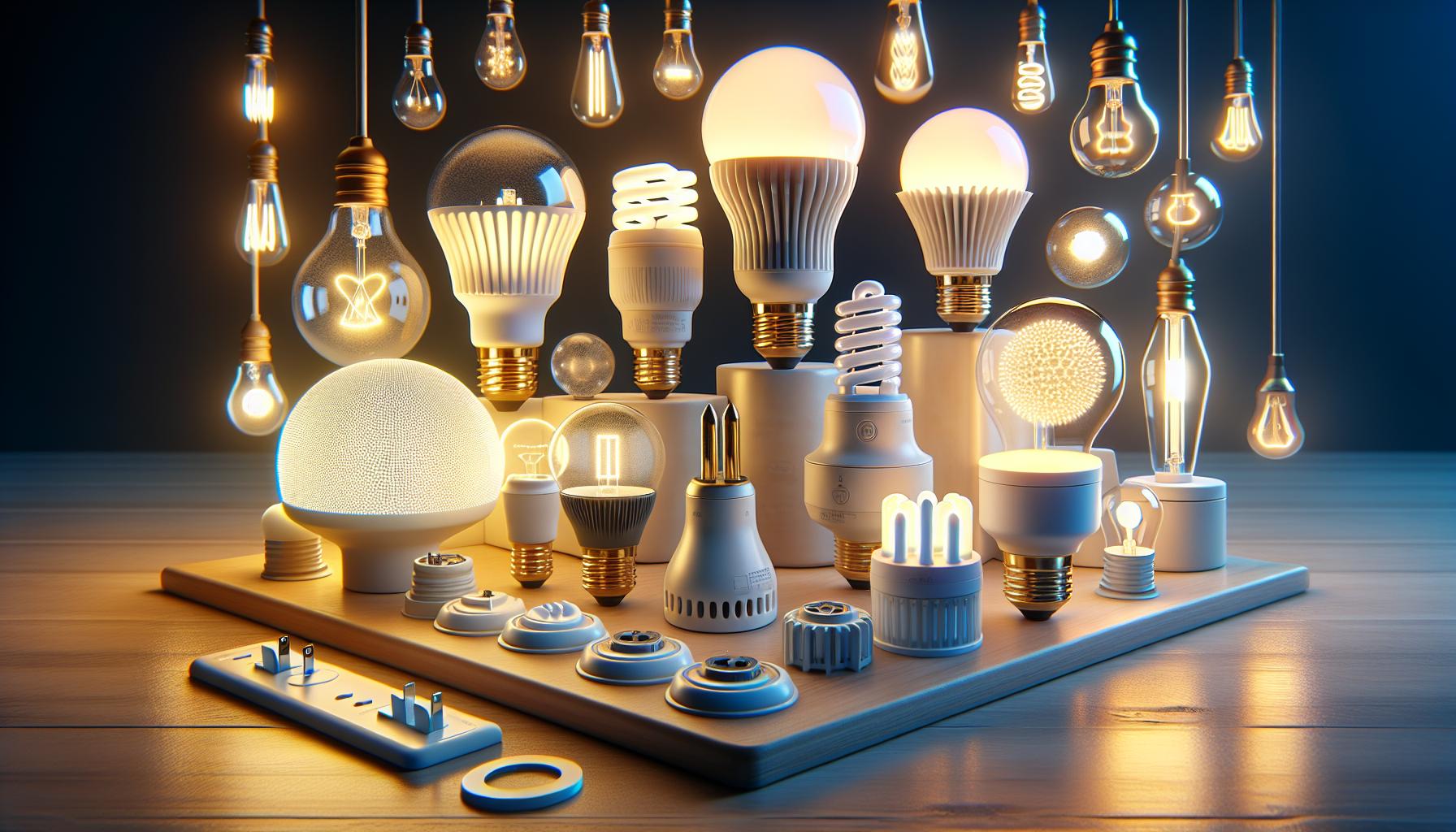Ever walked into a room and felt like the lights were just too bright? You’re not alone. Creating the perfect ambiance is all about lighting, and sometimes, you need a softer glow. Whether you’re setting the mood for a cozy evening or reducing glare for a movie night, dimming your lights can make all the difference.
Why Dimming Lights is Important
Ever had that moment when you flick on the switch and the room’s ablaze with light that’s just too harsh? Dimming your lights not only avoids this discomfort but also enhances the overall experience of your living space. It’s about personalizing your environment to match your mood or activity.
- Energy savings: Dimming lights can significantly reduce your electricity consumption.
- Prolongs bulb life: It can extend the life span of your bulbs.
Versatile Lighting for Every Occasion
Imagine hosting a dinner and the lighting is as flexible as your playlist, adding layers to the evening’s ambiance. You’ve got soft, warm light that encourages relaxation and conversation. Or picture tweaking the brightness to focus on a project—you’re crafting that DIY masterpiece and the lighting adjusts with your creative flow. It’s functional and spells out comfort in lumens.
Strain-Free Environment
Dimmer switches are your best pals when you’re settling down for a movie marathon or engrossed in a late-night novel. They help create a screen-friendly setting that reduces glare, minimizing eye strain and enhancing visual comfort. No more squinting or pausing to rub tired eyes.
Mood Alchemy with Light
Lighting has the power to transform a space, turning the average room into an enchanting retreat. Dimming that overhead glare to a gentle glow can transport you from a stressful day to a tranquil evening oasis. It’s not just about illumination—it’s about creating a feeling.
Subtle Transitions Through Time of Day
As the natural light from outside ebbs and flows, so too should the illumination indoors. Transition with the sun, dimming lights to signal the close of day and the approach of a restful night. It’s the perfect mimicry of the world’s rhythm, syncing your home’s lighting with the cycle of nature.
Take control of your surroundings and make your space a true reflection of your needs and preferences. With the right dimming setup, your lighting can dance to the beat of your lifestyle.
Different Ways to Dim a Light Bulb
When you’re aiming to set the perfect ambiance, knowing how to properly dim your light bulbs is key. Luckily, there are several different methods you can use to achieve your desired lighting levels.
Replacement Dimmer Switches are among the most common solutions. By swapping out your standard switches with these, you gain control over the brightness of your lights with just a simple turn or slide. It’s a more permanent solution that requires a bit of electrical know-how, but it’s well worth the effort.
« Is LED Light Bulbs Better? The Shocking Truth About Their Efficiency
Do You Need Special Light Bulbs for Bathroom? Brightness to IP Ratings Explained »
Next up are Plug-In Dimmers, which offer an easy, no-installation-required option. You simply connect your lamp into the dimmer, and then plug it into the wall. With a turn of the dial, you can adjust the brightness to your liking. It’s perfect for renters or those looking to avoid electrical projects.
Don’t overlook Smart Bulbs, which are a tech-savvy choice. You can control these bulbs via an app on your smartphone, setting the exact percentage of brightness you want or even changing colors if the bulb allows. Some can even be controlled with voice commands through smart home devices.
For those with a penchant for DIY, consider DIY Dimmer Circuits. If you have experience with electronics, building your own dimmer circuit can be a rewarding project. However, this is recommended only if you’re comfortable with the potential risks and complexities of working with electrical components.
| Bulb Dimming Method | Installation Complexity | Control Mechanism |
|---|---|---|
| Replacement Dimmer | Moderate | Wall Switch |
| Plug-In Dimmer | None | Dial/Remote |
| Smart Bulbs | None | Smartphone/App |
| DIY Dimmer Circuit | High | Custom-Built System |
Remember, when you’re dimming certain types of bulbs, especially LEDS, you’ll want to make sure that they’re clearly marked as “dimmable”. Non-dimmable bulbs can suffer a reduced lifespan or even be damaged when used with dimming mechanisms. With the right bulbs and a bit of know-how, you’ll have a softly lit oasis in no time. Keep exploring to find the method that best suits your space and lifestyle.
Using Dimmer Switches
When you want to dial down the glare to a cozy glow, a dimmer switch is your go-to solution. They’re the traditional method, but knowing how to pick and install the right one can save you a lot of hassle down the road. First, you’ve got to check if your light bulbs are compatible. Look for the “dimmable” label on the packaging, because non-dimmable bulbs can flicker or buzz when attached to a dimmer, which is not what you want for your chic dinner party.
Here’s a nifty tip: check the load requirement for your dimmer switch. That’s just a fancy way of saying figure out how much power it needs to handle. Your dimmer needs to match or exceed the total wattage of the light bulbs you’re using. Here’s an example to brighten up this point:
| Bulbs on Dimmer | Individual Bulb Wattage | Total Wattage |
|---|---|---|
| 4 | 60W | 240W |
So, for four 60W bulbs, you’d need a dimmer that can handle at least 240W.
With your compatible dimmer and bulb in hand, it’s time to talk installation. Hiring an electrician is the safest bet, but if you’re a DIY enthusiast, you’ll need to switch off the power at the breaker box first to avoid a shocking experience. Once the power’s off, dismantle the old switch and connect the new dimmer’s wires exactly how the previous ones were connected.
Think about the style of your dimmer, too. They come in various designs like rotating knobs, sliders, or touch panels, and some even have remote controls. Pick one that complements your room and is easy for you to adjust. After all, ease and functionality are the name of the game.
Remember, if you’ve got LED bulbs, ensure that your dimmer switch is specifically labeled as LED-compatible. LED bulbs require less power to operate, and the wrong switch can lead to uneven dimming or even damage your bulbs. In the radiant world of lighting, it’s all about the perfect match.
Installing Dimmer Switches
Embarking on the adventure of enhancing your home’s atmosphere with dimmable lighting, you’ll need to roll up your sleeves for the hands-on task of installing dimmer switches. Remember, it’s crucial to ensure power is turned off at the circuit breaker before you begin work. Safety first is your mantra when you’re diving into DIY electrical projects.
Begin by removing the faceplate of your current light switch and unscrewing the switch itself from the electrical box. Carefully pull it out to expose the wires. Here’s where you’ll notice three types of wires: live (usually black), neutral (white), and ground (green or copper). Your dimmer will also have similar wires or wire leads that you’ll need to connect.
Using wire strippers, prepare the wires from the dimmer switch by stripping them to the appropriate length, as indicated in the instructions. Creating secure connections is vital, so twist the ends of the corresponding wires together and cap them with wire nuts. For ground wires, you’ll sometimes find a screw on the electrical box meant specifically for this purpose.
After your wires are connected, gently push the dimmer switch into the electrical box and secure it with the screws provided. Double check that there are no loose wires and that your connections are snug. Finally, attach the dimmer faceplate, and feast your eyes on your upgraded, customizable lighting setup.
If any point of this feels overwhelming or complicated, don’t hesitate to bring in a professional electrician. While it’s gratifying to tackle home improvements, it’s equally important to acknowledge when a task is beyond your comfort zone. Safety and proper functioning take precedence over the satisfaction of a DIY job.
As dimmer switches come in a plethora of styles, including rotary, slider, toggle, and tap, choose a design that blends seamlessly with your space. Some modern dimmers also feature remote controls or smart home integration for an elevated lighting experience. Remember, dimmer switches aren’t just functional; they’re also an aesthetic choice that should enhance your space.
Other Methods of Dimming Lights
Beyond installing a dimmer switch, alternative methods exist to achieve the desired ambiance in your space through dimming lights. If you’re looking for a quick and fuss-free solution, these ways might just be your ticket to that perfect glow.
Smart Bulbs: A Bright Idea
Diving into the world of smart tech, smart bulbs stand out. They connect to your smartphone or smart home system, allowing you to adjust brightness levels with just a few taps. Here’s what you need to know:
- Compatibility: Check if they’re compatible with your home automation system.
- Features: Some offer features like scheduling and color change.
- Installation: They screw in like regular bulbs, so no wiring hassles.
Plug-in Dimmers: An Easy Alternative
If you’re not ready to change out switches, consider plug-in dimmers. These devices are great for floor and table lamps, and they’re as simple as it gets:
- Connection: Plug your lamp into the dimmer and the dimmer into the wall.
- Operation: Use a slider or dial on the unit to adjust the light level.
Light-Dimming Films: Filter it Out
For those who want to tone down the brightness without tinkering with electricity, light-dimming films could be the answer. They adhere to the bulb’s surface:
- Easy Application: Just cut to size and stick on.
- Flexibility: Available for various bulb shapes and sizes.
- Effect: Not just dimmer, but a softer, diffused light.
Remember, when you’re experimenting with these methods, it’s always critical to ensure that your chosen method is safe for use with the bulbs you have. Some bulbs, like LEDs, may require specific types or brands of dimmers to function properly. Always read product details and reviews to ensure you’re making an informed decision that’ll light up your life, just the way you want.
Conclusion
You’ve got the know-how to transform your bright bulbs into a softer glow that suits your mood. Whether it’s through smart bulbs, plug-in dimmers, or light-dimming films, you’re equipped to take control of your space’s ambiance. Just remember to double-check for safety and compatibility. Now, go ahead and set the perfect tone for your cozy evening in or your next get-together. Enjoy your new, dimmer-lit oasis!
Frequently Asked Questions
What are smart bulbs?
Smart bulbs are advanced lighting options that allow control over brightness and color through a smartphone or smart home system. They offer convenience and flexibility for dimming lights.
Can I use a plug-in dimmer for my lamps?
Yes, plug-in dimmers are an easy-to-use alternative for controlling the brightness of lamp lighting. Just ensure your lamp is compatible with the dimmer you choose.
Are light-dimming films a good option for dimming lights?
Light-dimming films can be a good non-electrical option to reduce the brightness of a room. They are applied directly to the window to filter incoming light.
Is it important to make sure the dimming method is compatible with my bulbs?
Absolutely, ensuring the dimming method you choose is compatible with your bulbs is crucial for safety and optimal functionality. Always check compatibility before purchase and installation.





